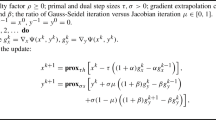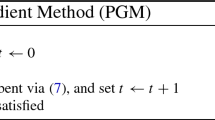Abstract
Recently, a golden ratio primal-dual algorithm (GRPDA) was proposed by Chang and Yang for solving structured convex optimization problems. It is a new adaptation of the classical Arrow-Hurwicz method by using a convex combination step, instead of the widely adopted extrapolation technique. The convex combination step is determined by a parameter \(\psi \), which, to guarantee global convergence, is restricted to \((1, (1+\sqrt{5})/2]\). In this paper, by carrying out a refined analysis, we expand this region to \((1, 1+\sqrt{3})\). Moreover, we establish ergodic sublinear convergence rate results based on function value residual and constraint violation of an equivalently reformulated constrained optimization problem, rather than the previously adopted so-called primal-dual gap function that could vanish at nonstationary points. For linear equality constrained and regularized least-squares problems, we further show that GRPDA and Chambolle-Pock’s primal-dual algorithm are equivalent provided that some parameters are chosen properly. Finally, experimental results on the LASSO and the basis pursuit problems are presented to demonstrate the performance of GRPDA with \(\psi \) being chosen in the expanded region.






Similar content being viewed by others
Data Availibility
The datasets generated during and/or analysed during the current study are available from the corresponding author on reasonable request.
References
Arrow, K.J., Hurwicz, L., Uzawa, H.: Studies in linear and non-linear programming. Stanford Mathematical Studies in the Social Sciences, II. Stanford University Press, Stanford, Calif. With contributions by Chenery, H.B., Johnson, S.M., Karlin, S., Marschak, T., Solow, R.M (1958)
Bertsekas, D.P., Gafni, E.M.: Projection methods for variational inequalities with application to the traffic assignment problem. Math. Program. Study 17, 139–159 (1982)
Bouwmans, T., Aybat, N.S., Zahzah, E.H.: Handbook of “Robust low-rank and sparse matrix decomposition: applications in image and video processing”, 45. (2016)
Chambolle, A., Pock, T.: A first-order primal-dual algorithm for convex problems with applications to imaging. J. Math. Imagin Vis 40(1), 120–145 (2011)
Chang, X., Yang, J.: A golden ratio primal-dual algorithm for structured convex optimization. J. Sci. Comput 87(2), 1–26 (2021)
Chang, X., Yang, J., Zhang, H.: Golden ratio primal-dual algorithm with linesearch. SIAM. J. on Optimiz 32(3), 1584–1613 (2022)
Chen, S.S., Donoho, D.L., Saunders, M.A.: Atomic decomposition by basis pursuit. SIAM. J. Sci. Comput. 20(1), 33–61 (1998)
Donoho, D.: Compressed sensing. IEEE. Trans. Inform. Theory 52(4), 1289–1306 (2006)
Esser, E., Zhang, X., Chan, T.F.: A general framework for a class of first order primal-dual algorithms for convex optimization in imaging science. SIAM. J. Imagin. Sci. 3(4), 1015–1046 (2010)
Hayden, S., Stanley, O.: A low patch-rank interpretation of texture. SIAM. J. Imagin. Sci 6(1), 226–262 (2013)
He, B., You, Y., Yuan, X.: On the convergence of primal-dual hybrid gradient algorithm. SIAM. J. Imagin. Sci 7(4), 2526–2537 (2014)
He, B., Yuan, X.: Convergence analysis of primal-dual algorithms for a saddle-point problem: from contraction perspective. SIAM. J. Imagin. Sci 5(1), 119–149 (2012)
Jiang, X., Vandenberghe, L.: Bregman three-operator splitting methods. arXiv:2203.00252
Li, L., Yan, M.: On the improved conditions for some primal-dual algorithms. arXiv:2201.00139
Malitsky, Y.: The primal-dual hybrid gradient method reduces to a primal method for linearly constrained optimization problem. arXiv:1706.02602
Malitsky, Y.: Golden ratio algorithms for variational inequalities. Math. Program 184, 383–410 (2020)
Malitsky, Y., Pock, T.: A first-order primal-dual algorithm with linesearch. SIAM. J. Optimiz 28(1), 411–432 (2018)
Needell, D., Ward, R.: Near-optimal compressed sensing guarantees for anisotropic and isotropic total variation minimization. IEEE. Transact. Image. Process 22(10), 3941–3949 (2013)
Rockafellar, R.T.: Convex analysis. Princeton University Press, New Jersey (1970)
Sabach, S., Teboulle, M.: Faster lagrangian-based methods in convex optimization. SIAM. J. Optimiz 32(1), 204–227 (2022)
Shefi, R., Teboulle, M.: Rate of convergence analysis of decomposition methods based on the proximal method of multipliers for convex minimization. SIAM. J. Optimiz 24(1), 269–297 (2014)
Sun, D., Toh, K.-C., Yang, L.: A convergent 3-block semi-proximal alternating direction method of multipliers for conic programming with \(4\)-type of constraints. SIAM. J. Optimiz 25(2), 882–915 (2015)
Tibshirani, R.: Regression shrinkage and selection via the lasso. J. Royal. Stat. Soc 58(1), 267–288 (1996)
Yang, J., Zhang, Y.: Alternating direction algorithms for \(\ell _1\)-problems in compressive sensing. SIAM. J. Sci. Comput 33(1), 250–278 (2011)
Funding
The authors have not disclosed any funding.
Author information
Authors and Affiliations
Corresponding author
Ethics declarations
Conflict of interests
The authors have no relevant financial or non-financial interests to disclose.
Additional information
Publisher's Note
Springer Nature remains neutral with regard to jurisdictional claims in published maps and institutional affiliations.
X. Chang author was supported by the NSFC grant 12161053 and the Natural Science Foundation for Distinguished Young Scholars of Gansu Province (22JR5RA223). J. Yang was supported by NSFC grants (11922111, 12126337) and Ministry of Science and Technology of China (2020YFA0713800).
Rights and permissions
Springer Nature or its licensor (e.g. a society or other partner) holds exclusive rights to this article under a publishing agreement with the author(s) or other rightsholder(s); author self-archiving of the accepted manuscript version of this article is solely governed by the terms of such publishing agreement and applicable law.
About this article
Cite this article
Chang, X., Yang, J. GRPDA Revisited: Relaxed Condition and Connection to Chambolle-Pock’s Primal-Dual Algorithm. J Sci Comput 93, 70 (2022). https://doi.org/10.1007/s10915-022-02033-0
Received:
Revised:
Accepted:
Published:
DOI: https://doi.org/10.1007/s10915-022-02033-0
Keywords
- Structured convex optimization
- Primal-dual algorithm
- Golden ratio
- Convex combination
- Ergodic sublinear convergence rate




